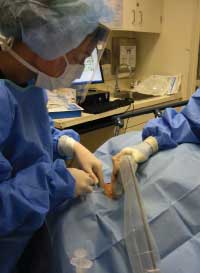Choose Point-of-Care Ultrasound First
The more we learn about clinical ultrasound, the more we agree with the growing body of literature that indicates ultrasound is underutilized. In fact, we believe along with the American Institute of Ultrasound in Medicine (AIUM) that, in many scenarios, it should be the first—and only—tool necessary to aid in diagnosis or guide an invasive procedure.
Many clinicians are unaware of the range of conditions for which ultrasound first is an established guideline, and the gap only grows larger as research extends ultrasound's diagnostic value.
—From AIUM's campaign website, www.UltrasoundFirst.org
We, however, go beyond advocating for just the increased use of ultrasound. As pioneers in the creation and use of point-of-care (POC) ultrasound (aka, bedside ultrasound), we have seen its benefits in many circumstances reach beyond those of conventional ultrasound. Consequently, we encourage clinicians and medical center administrators to consider choosing point-of-care ultrasound first:
- To scan for trauma
- To assist with diagnosis
- To guide invasive procedures
- To reduce time, money, and space
POC first to scan for trauma
Experience is demonstrating that, in critical situations like accident and trauma, employing ultrasound at the point of care can have a profound effect on outcome. In such cases where patients are mostly immobile, hand-carried technology can reach patients where they are, be it along the roadside, in remote jungle village, or following major disasters. The immediate results obtained through onsite ultrasound can hasten diagnosis, which, in turn, can lead to more appropriate follow-up interventions.
POC first to assist with diagnosis
Point-of-care ultrasound has proven itself to be an effective diagnostic tool that is comparable to, and oftentimes, preferable to other forms of imaging modalities. Because ultrasound emits no ionizing radiation, it is a safe option that should be considered before selecting other diagnostic modalities that subject patients to radiation exposure.
POC first to guide invasive procedures
The implementation of point-of-care ultrasound technology enables medical professionals to perform precision-based procedures and treatments under direct ultrasound visualization. A growing number of studies indicate that use of ultrasound guidance by physicians may improve success and decrease complications in central line placements, peripheral vascular access, regional anesthesia (nerve blocks), lumbar puncture, biopsies, thoracentesis, paracentesis, arthrocentesis, incision and drainage of abscesses, and localization and removal of foreign bodies.

POC first to reduce time, money, and space
Point-of-care ultrasound is helping reduce hospital and patient expenses by reducing cost to the health system and the time required for diagnosis and treatment. Because hand-carried POC systems are so much smaller than conventional cart-based systems—and because mountable POC machines like most of Sonosite's leave a "zero footprint" in locations where space is at a premium—POC has also found its way into remote corners of the world where funds, facilities, and space are limited.
As evidential reasons for choosing POC ultrasound first continue to mount, Sonosite will continue to promote its use as indispensable in the practice of good and conscientious medicine.


